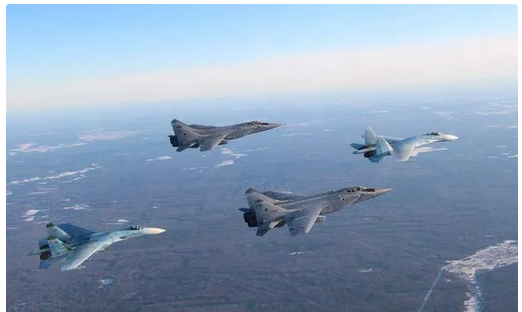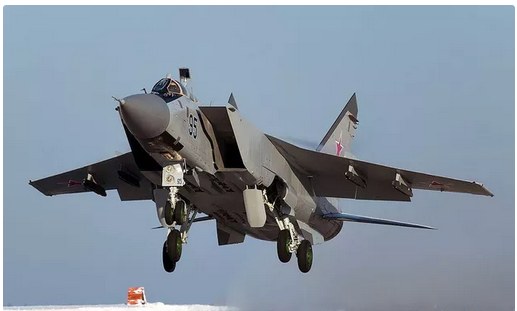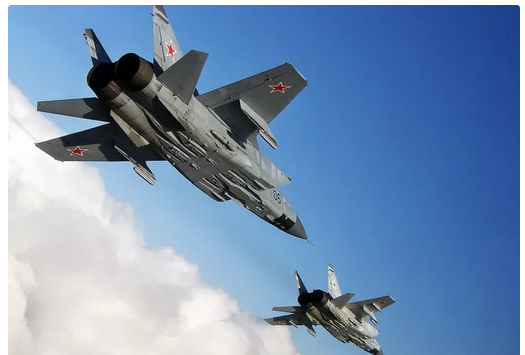Russian MiG-31 high-speed interceptor fighter jet
NATO and the United States are both afraid of Russia's weapon, which is the MiG-31 high-speed interceptor fighter jet. Its flight speed can exceed 2.8 Mach and it can carry long-range air missiles to deliver lethal strikes to invading enemies. In recent years, Russia has equipped the MiG-31 with a long-range strategic weapon - the Dagger hypersonic missile, which allows the MiG-31 to serve as aAircraft that strike ground targets and sea targets, Kh-47M2Missiles can threaten various ground and sea targets within a range of up to 2000 kilometers with high reliability, accuracy, and a speed of 10 Mach.
This is naturally what the United States is afraid of, because airborne anti-ship weapons are currently a challenge for surface fleet interception. The threshold for launching airborne weapons is lower, the speed is faster, and the distance is farther. For the US aircraft carrier fleet, the difficulty of early warning will be greater, and the difficulty of interception will also increase accordingly.

The MiG-31 interception fighter has a fuselage length of 22.62 meters and a wingspan of 13.45 meters. It can be said that there are few fighter jets that can exceed the specifications of the MiG-31. Even the heavy fighter Su-27 has a length of only 21.9 meters and a wingspan of 14.7 meters. Most importantly, the MiG-31 has a relatively thick body, making the Su-27 appear very thin in front of the MiG-31.The emergence of the interceptor was a type of interceptor designed during the Soviet era to meet the requirements of national air defense and meet the needs of the country. It is more focused on interception rather than multi-purpose use, so its mission is single and the cost of use is relatively high. This is also one of the reasons why the MiG-31 is difficult to sell, as other countries do not have an urgent demand for this type of aircraft.
The MiG-31 has a long range capability, with a combat radius of 1500km and a range of 5400km after aerial refueling. For a country with a vast territory like Russia, the MiG-31 can indeed provide a rapid response capability. Especially in the face of the advantage of the US Air Force, the MiG-31 is particularly important. However, in recent years, Russia has also been focusing more on developing multi-purpose fighter jets. After all, the Su-35S and Su-57 can fully play the role of the MiG-31 in the future. Although the current MiG-31 can still play a significant role in interception, it will not be the only one in the futureIntercept aircraft models.

So, Russia has also recognized the singularity of the MiG-31 mission and is upgrading its versatility by equipping it with powerful hypersonic weapons, which is a means of unleashing the MiG-31's vitality. Similarly, there is the Tu-22M3 bomber, which mainly targets surface targets and also has the ability to carry daggers. It is not difficult to see that even strategic weapons are developing towards conventional strike capabilities. Even the US B-1B, due to later modifications, can be equipped with anti-ship weapons to carry out strike missions against surface vessels. This is all to enable some weapons to achieve conventional combat capabilities, with the aim of saving costs and "reusing" them.As an interceptor fighter, it can adapt to more combat scenarios and alleviate the pressure on the Russian Air Force. Especially its advantage in flight speed, with extremely fast response capabilities for the Baltic Fleet and the Pacific direction, is one aspect of Russia's deterrent power.Imagine if a US bomber suddenly intruded into Russian airspace, the MiG-31 could arrive at the scene at the same distance and in the shortest possible time for expulsion.

It also fully demonstrates the complexity of Russia's combat environment. The country has a large territory and faces threats from multiple directions, which requires different fighter jets to meet different threat points. The Su-34 was also born in this context. In addition, the Kirov class cruisers and heavy anti-ship missiles developed by the former Soviet Union to counter the United States' naval power have their own unique characteristics.
Source: Military of Strong Countries